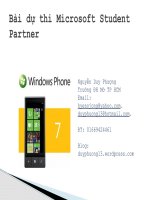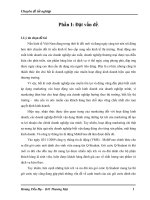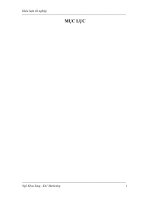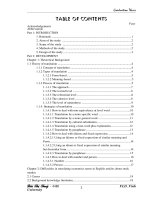STUDENT CHEATING
Bạn đang xem bản rút gọn của tài liệu. Xem và tải ngay bản đầy đủ của tài liệu tại đây (154.86 KB, 11 trang )
Website: Email : Tel (: 0918.775.368
STUDENT CHEATING
Table of contents:
Abstract............................................................................................1
I. Introduction........................................................................................1
II. Content...............................................................................................2
1. How do students cheat?...........................................................................2
1.1 “Qualifying” the teachers/ professors....................................................2
1.2 Collaborative cheating...........................................................................4
a, Tactical deployment..............................................................................4
b, Semiotic methods.................................................................................4
1.3 Solitary cheating....................................................................................4
2. Why do they cheat?.................................................................................5
2.1 External factors.......................................................................................5
2.2 Internal factors........................................................................................6
2.3 The responsibilities of teachers/ professors and parents. ......................7
3. Suggested effective solutions...................................................................7
III. Conclusion.....................................................................................8
IV. References........................................................................................9
Topic: Student cheating
Date : December 21
st
, 2009
Student name : Pham Nhu Quynh
Student number: CQ483995
Class : Bussiness English 48A1
Abstract:
This report investigates the current state of cheating by students. Based on the information
from 100 students from colleges and universites, the discussion focuses on three main parts:
how do students cheat, why do they cheat and solutions . The first part examines the variety
of creative tactics that students use to cheat during in class examinations. Findings indicate
that students manipulate variables divided into “qualifying” the teachers/ professors,
collaborative cheating, solitary cheating. In the second part, it analyzes internal and external
factors that influence students’ behaviors. It is also suggested some solutions by both
students surveyed and the reporter.
I. Introduction:
Cheating is present in our society. We see cheating in the games we play, in the lives we lead
and in our classrooms.
The literature on academic dishonesty provides a structural framework for understanding
exactly what constitutes cheating. It also documents the social and personal characteristics of
cheaters, their motives, where they are most likely to cheat, and when they are most likely to
cheat; but where the literature is less thorough is when it comes to documenting what the
students do to cheat-that is, how they cheat and why they do that. This gap in the literature
exists because the techniques and tactics that students use to cheat have been largely
presupposed rather than thoroughly examined and the reasons also diversify along with the
time and social environment.
This paper examines the varieties of creative tactics that students use to cheat during in-
class examinations as well as analysizes the most recent and important reasons causing this
tension.
Based upon this study, specific techniques for enforcing academic integrity during in-
class examinations will be suggested along with speculations as to the emotional and moral
attractions of academic dishonesty.
2
II.Content:
1. How do students cheat?
McCabe and Bowers (1994, p. 7) define the parameters of cheating on
tests/exams as:
1) copying from another test or exam
2) helping someone on a test
3) using a crib note
4) copying from someone without their knowledge (see also
McCabe and
Trevino,1996, p. 31).
Smith’s work offers a more specific way of differentiating and classifying cheating on
tests, but his questionnaire also implicitly hints that there might be other places and ways
that crib notes may be creatively imported and used during an exam. This leads to a
logical question: what type of innovative and creative tactics do students use to cheat during
in-class examinations? And once crib notes are used, what strategies do students use to
destroy the evidence of their illicit actions? Newstead et al. (1996) and Smith (2000) note
that prearranged signal systems are used to receive or communicate answers to and from
others; if this is so, are hand signals and tapping one’s pencils the only way that cheating
occurs? How do students avoid the obvious possibility of drawing the teacher’s suspicions
while employing such intrusive methods of communication?
This study was concerned with identifying and classifying the specific techniques that
students use to cheat during in class exams; it was exploratory in nature, designed to elicit
detailed narratives. Consequently, no hypotheses were tested. Rather than only using pre-
formulated surveys, students were instructed to be as detailed and as descriptive as possible
in their narratives.To capture the authenticity of students’ experiences, I
have chosen to let the students represent their own stories, in their own ungrammatical
voices besides completing a semi-structured questionnaire.
The data for this study were collected from 100 students from colleges and universties in
the first half of December, 2009. Each student was asked to complete a semistructured
questionnaire. The students were asked two questions:
1) Have you ever cheated during an in-class examination? (Cheating was defined as copying
a test from others, using unauthorized crib notes and “cheat sheets” during an exam.)
2) If students answered “yes” to (1), they were directed to a second question which asked
them to write a detailed narrative as to how they cheated—the specific tactics they used
to cheat during in-class examinations.
There were wide variations in the length and detail of students’ narratives; for the
purposes of this paper, narratives that are rich in descriptions and representative of the
analytical category under discussion are chosen as examples.
1.1 “Qualifying” the Professor
“Despotic professors incur the deviant wrath of their students, thus facilitating their
justifications and rationalizations for cheating” (Haines et al., 1986; McCabe, 1992).
Practically, however, students who decide to cheat on in-class exams have to find innovative
ways to avoid the surveillance of professors and teaching assistants. Thus, in
addition to completing the exam, students who decide to cheat must first determine their
potential for success; to this end, they engage in a “qualifying” process whereby they
determine if “the person is desirable as a victim” (Leo, 1996, p. 266).
3
Essentially, students “size up” their teachers, testing their vigilance. This process is
similar to the way police detectives “size up” a suspect in an interrogation room. Students,
too, create a psychological “profile” of their professors, and creat suitable ways to dupe
them. In common, student makes a distinction between regular faculty members and
department chairs, assuming that the courses taught by department chairs are substantively
more difficult, the teacher more vigilant and strict—“hard” (“she would not play any
games”). That assumption is initially confirmed after one or two lessons and one test. After
the first test, however, the student re-evaluates the professor’s suitability as a potential target
for cheating after discovering an obvious limitation in the professor’s surveillance capability:
she has to remain stationary, hence, limited in her field of vision. Furthermore, the student
relies on her knowledge of situational routines to mobilize and execute her illegitimate plans.
In this excerpt, the student “sizes up” the professor’s constraints in her mobility, range and
scope of her surveillance, and typifications of test administration and uses them to her unfair
advantage; consequently, she is able to successfully cheat without detection.
A student elaborates in considerable detail how he “sizes up” the professor and
constructs a working “profile”:
How do you do it (cheat) without getting caught?
The first way is by knowing the professor. What I mean by that is knowing and
understanding your professors habits and routines, especially you have to notice his habits
and routine in the classroom… Another thing learn his interests. What I mean by
that is notice if he brings a magazine or newspaper and if he does this everyday. If you see
him reading something on campus, notice what it is and how long he’ll read than look up.
Bring a watch. Most people begin reading something they like and forget what they are
supposed to be doing and in about 5 minutes they’ll look up to see where they are or look at
their watch to remember what they have to do. After you notice these things a few times your
set. If you are going to a test and he comes in with a magazine or paper he read daily or
every other day, you got him. You’ve already studied his reading habits and you know about
how often he’ll look up at the class. Say he looks up about every 3 minutes. You know you
have at least 2 minutes to cheat so now you got him. He is unaware of his thought less
routines or habits so the chance of getting caught in
virtually gone. Oh, another things, remember that group or people
you learned your professor likes or is his favorites. You want to be one of them. Why?
Because someone who pretends to pay attention or participates will be most unlikely to
cheat right? Well, that’s what your professor thinks. So you need to participate and ask
questions you know only your professor would know so he thinks your trying to learn. This is
very effective.
The first noteworthy—and impressive—point about the way this student “sizes up” the
professor. The student does not just observe the teacher; he collects, sorts, and analyzes
behavioral data, carefully noting the professor’s reading habits, body and eye movements,
and general comportment in the classroom. By knowing the professor’s habits and routines,
the student is able to delineate the situational, normative, and temporal boundaries of illicit
action; moreover, such systematic observations reveal the victim’s vulnerabilities and
weaknesses. In other words, the student knows what he can get away with and how long he
can look at his cheat sheet.
The second noteworthy point is that the student actually “cultivates” the professor,
meaning that the student manipulates the professor through a “pattern of psychological
dependence” (see Leo 1996, p. 271). Like a good confidence man or a car salesman, an
experienced cheater exploits the weaknesses of professors and betrays his/her trust for a
chance to improve his/her grade. Once students have “sized up” their professors, and have
4
decided to cheat (or not), then they must decide if they are going to cheat alone or do so in
collusion with others.
1.2 Collaborative cheating
Some cheating methods are just uncouth and unimaginative: students sit in the back of
the room and blatantly whisper answers back and forth to one another. In this section, some
of the recurring, yet not so obvious, methods that students use to cheat in conjunction with
their peers are discussed.
a, Tactical Deployment:
Tactical deployment refers to the strategic ways that students position themselves in
relation to others; this method requires students to be situated in a zone of maximal
surveillance in the proximity of someone who has studied for the exam, one who may or may
not be an accomplice. Usually, this person is considered the “smart” one in the class, and
those who seek his/her assistance simply peek at their answers unbeknownst to their victims:
When I cheated myself & some buddies would position ourselves around the smartest one in
the class and the one closest would copy and then we would copy off
of him. Cheat sheets are to risky you can get caught
Collaborative cheating requires a willing (active) or an unwitting (passive) participant,
and is intricately related to environmental and social influences. To cheat successfully with
others, a “smart” confederate- one who actually studies for the exam- is necessary (see
Cizek, 1999). Moreover, the confederate must be willing to participate in the scheme. The
person who allows his/her work to be copied can be conceptualized as a passive- social
cheater since his/her role is minimally active (see Hetherington and
Feldman, 1964).
Through tactical and strategic body placement, several students are able to cheat
successfully without detection. But what is noteworthy here is the incremental and sequential
nature of collaborative cheating: no one individual bears an unfair
load of the dishonest work; each participant’s role in the scheme is divided, thus diminishing
the likelihood of group detection and reducing the culpability of the involved parties. The
next innovative method of collaborative cheating involves more than spatial positioning; it
requires communicative participation.
b, Semiotic Methods:
Another method of cheating that was successful on multiple choice tests for a while was
using signs. This would work in the classes that had students facing each other. For
example, I would watch a student and he or she would signal me the answer by touch the
nose for A, touch the chin for B, the ear for C, and finally touch the top of the head for
answer D. This method was harder so we had to pay attention and stay on the same
question.
Coughing once for A, twice for B and so on, students rely on non-verbal communication
methods of cheating so as to not draw attention to themselves. This
method is advantageous in that it eliminates from the outset the leaving behind of potentially
incriminating evidence (e.g., crib notes).
1.3 Solitary cheating
Collaborative cheaters deploy themselves in strategic ways in relation to “smart”
confederates; if the “smart” person is not an accomplice, then the one whose work is
surreptitiously copied is not a passive cheater but a victim—a victim of theft (see Bunn et al.,
1992).
Using crib notes (“cheat sheets”) is mentioned as a primarily way of solitary cheating as
well as peeking at someone else’s answer sheet, writing the answers on the bottom of one’s
5









